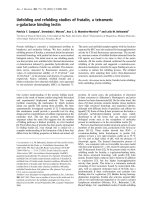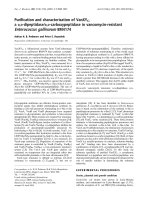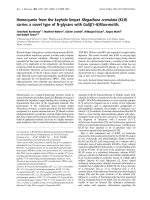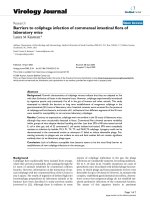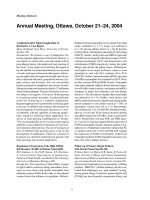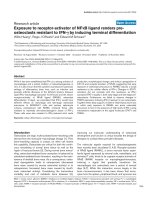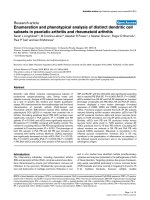Báo cáo y học: "Barriers to the implementation of programs for the prevention of mother-to-child transmission of HIV: A cross-sectional survey in rural and urban Uganda" pptx
Bạn đang xem bản rút gọn của tài liệu. Xem và tải ngay bản đầy đủ của tài liệu tại đây (259.07 KB, 7 trang )
BioMed Central
Page 1 of 7
(page number not for citation purposes)
AIDS Research and Therapy
Open Access
Research
Barriers to the implementation of programs for the prevention of
mother-to-child transmission of HIV: A cross-sectional survey in
rural and urban Uganda
Francis Bajunirwe*
1,2
and Michael Muzoora
1
Address:
1
Department of Community Health, Mbarara University of Science and Technology, P.O. BOX 1410, Mbarara Uganda and
2
Case Western
Reserve University, School of Medicine, Department of Epidemiology and Biostatistics, 10900 Euclid Avenue, Cleveland OH, 44106-4945 USA
Email: Francis Bajunirwe* - ; Michael Muzoora -
* Corresponding author
Abstract
Background: Implementation of programs for the prevention of mother-to-child transmission
(PMTCT) of HIV faces a variety of barriers and challenges. The assessment of these challenges has
generally been conducted in large urban health facilities. As programs expand into rural areas, the
potential barriers that may be encountered there also need to be assessed. This study examines
potential barriers that might affect the acceptability of interventions for PMTCT in rural and urban
settings.
Results: Four hundred and four women at a large urban hospital and three rural clinics that had
recently started implementing PMTCT were interviewed. Level of knowledge of MTCT and
preference for rapid HIV testing were equally high in both areas, but rural women had a higher
tendency to think that they should consult their husbands before testing, with borderline statistical
significance (72% vs. 64% p = 0.09). Health facility-based deliveries were significantly lower among
mothers in rural areas compared to those in the urban setting. Overall, significant predictors of
willingness to test for HIV were post-primary education (OR = 3.1 95% CI 1.2, 7.7) and knowledge
about rapid HIV tests (OR = 1.8, 95% CI 1.01, 3.4). The strongest predictor of willingness to accept
an HIV test was the woman's perception that her husband would approve of her testing for HIV.
Women who thought their husbands would approve were almost six times more likely to report
a willingness to be tested compared to those who thought their husbands would not approve (OR
= 5.6, 95% CI 2.8, 11.2).
Conclusion: Lessons learned in large urban hospitals can be generalized to rural facilities, but the
lower proportion of facility-based deliveries in rural areas needs to be addressed. Same-day results
are likely to ensure high uptake of HIV testing services but male spousal involvement should be
considered, particularly for rural areas. Universal Primary Education will support the success of
PMTCT programs.
Published: 28 October 2005
AIDS Research and Therapy 2005, 2:10 doi:10.1186/1742-6405-2-10
Received: 17 July 2005
Accepted: 28 October 2005
This article is available from: />© 2005 Bajunirwe and Muzoora; licensee BioMed Central Ltd.
This is an Open Access article distributed under the terms of the Creative Commons Attribution License ( />),
which permits unrestricted use, distribution, and reproduction in any medium, provided the original work is properly cited.
AIDS Research and Therapy 2005, 2:10 />Page 2 of 7
(page number not for citation purposes)
Background
Short course antiretroviral regimens for the prevention of
mother-to-child transmission of HIV are cost effective [1],
easy to administer, and for these reasons, are being scaled
up in many developing countries [2,3]. Despite the low
cost for these short course regimens, implementation of
programs for the prevention of mother-to-child transmis-
sion (PMTCT) of HIV faces many challenges. Some of
these challenges include the low uptake of Voluntary
Counseling and Testing (VCT) [4-7], failure to return for
HIV test results [8] or failure to return for follow up visits
before starting antiretroviral therapy [9].
These challenges affect program components differently,
and consequently success of each program implementa-
tion as a whole has varied quite remarkably. The program
components in PMTCT include VCT for HIV during preg-
nancy, comprehensive antenatal care, infant feeding
counseling and administration of short course antiretrovi-
ral therapy regimen, intrapartum and postnatal care. For a
given program, there may be variation in the success with
some program components performing well, while others
fail. For example, acceptability of HIV testing may be high
but collection of test results and mother-child follow ups
are not as successful [10].
Most of the research to assess barriers that may hinder the
success of PMTCT program components has been con-
ducted at large urban hospitals [11-14] and it is not clear
whether these experiences can be generalized to rural
facilities. In many developing countries, the population is
predominantly rural and the majority of women seek care
at their rural health units. There are significant differences
in the socio-demographic structure of populations that
live in urban versus rural areas in most of Africa with
urban populations being more educated and economi-
cally advantaged compared to the rural population. A
recent study from the Ivory Coast has shown that socio-
demographic factors may be associated with participation
by HIV positive women in an intervention for PMTCT
[15]. The objective of this survey was to assess knowledge
of Mother-to-Child Transmission (MTCT) of HIV and to
describe the potential barriers that might affect acceptabil-
ity of interventions for PMTCT, particularly rapid testing
for HIV and short course antiretroviral therapy among
mothers in rural and urban settings.
Methods
This is a cross-sectional study conducted over a period of
four months between September and December 2003.
Face to face interviews were administered to mothers
attending antenatal clinics in rural and urban parts of
Mbarara, a district in southwestern Uganda. The PMTCT
program in Mbarara district started in August 2002 at
Mbarara University Hospital, the regional referral hospi-
tal. In February 2003, a scale-up program to the peripheral
rural health units started, with support from Elizabeth
Glaser Pediatric AIDS Foundation. When this survey was
conducted, the program had been in operation for one
year at the urban hospital and six months at the rural
health units.
Mothers were enrolled consecutively for face to face inter-
views from Mbarara University Hospital antenatal clinic,
an urban setting, and also from three rural health units at
county level in Ibanda, Bwizibwera, and Kazo, that were
each implementing PMTCT.
Mothers received information about the study during
their visit to the antenatal clinic and were requested to
participate. Informed consent was obtained by a trained
counselor, who carried out the interview as well.
Sample size and analysis
Survey items were socio-demographic characteristics,
knowledge on mother-to-child transmission of HIV, atti-
tudes towards voluntary counseling and testing (VCT) and
mothers' willingness or intention to accept rapid testing
for HIV if it were offered. Mothers were enrolled consecu-
tively until the required sample size was achieved. How-
ever, as part of the survey, the mothers were not followed
to determine those who eventually accepted HIV testing.
Sample size calculation was based on estimates for the
level of acceptance of rapid HIV tests in rural and urban
areas. We hypothesized that the intention to accept rapid
HIV tests would be higher in urban health units compared
to rural units. At the time the survey was designed, VCT
acceptance rates using rapid tests were 60% at antenatal
clinics in urban settings [16] and we projected the accept-
ance rates to be 45% in the rural setting. Using a two sided
alpha level of 5%, a sample size of 165 per group would
provide a power of 80% to detect a difference of 15% in
the proportion of those willing to accept HIV rapid tests.
Data was entered into EPIDATA software, and analysis
was performed using SPSS (Version 13 for Windows). Chi
square testing was used to test for differences in demo-
graphic characteristics between rural and urban mothers.
Chi square tests were also conducted to test for differences
in perceptions and attitudinal factors between the two
groups. Unconditional logistic regression was performed
to determine the factors that predicted the intention to
accept rapid HIV testing.
Results
Demographics
Four hundred and four pregnant women attending four
antenatal clinics where PMTCT services were offered at the
time were interviewed. The antenatal clinic in Mbarara
University Hospital is located in an urban setting, while
AIDS Research and Therapy 2005, 2:10 />Page 3 of 7
(page number not for citation purposes)
the other three clinics are rural. Of the 404 respondents,
212 (52%) were urban, while 192 (48%) were rural. The
majority of respondents had received some schooling
(369 or 91%), while only 35 (9%) had never been to
school. In addition, literacy among the respondents was
high, with 348 or 88% of the women able to read and 332
or 86% of them able to write. Most of the women were
married and living with their spouse (348 or 88%), while
44 (11%) were single mothers and the remainder were
separated, divorced or widowed. The number of women
pregnant for the first time (prime gravida) was the same in
the rural and urban areas. Radio ownership was high in
both rural and urban areas but higher in urban areas.
Table 1 shows the demographic characteristics stratified
by location of the clinic.
Knowledge about MTCT and prevention
Overall knowledge regarding MTCT was high, and 325
(80%) knew that a mother with HIV can pass the virus to
her child. However, 47 (12%) mothers interviewed did
not think that it was possible for the virus to be passed to
the unborn baby, and the remaining 8% did not know
whether the virus can be passed from mother to child. The
survey shows that 159 (83%) mothers in the rural area
knew that MTCT can occur compared to 166 (81%) moth-
ers in the urban area (Chi square p = 0.77, df = 2). These
figures demonstrate that the level of knowledge did not
differ significantly between the mothers in the rural set-
ting compared to those in the urban areas.
The mothers were also asked whether HIV could be trans-
mitted through breast milk and overall, 268 (77%) knew
that breast transmission of HIV was possible. Thirty eight
(11%) thought that breast transmission of HIV was not
possible and 41 (12%) did not know whether breast milk
could cause HIV transmission or not. Fifty seven mothers
did not answer this question and therefore were not eval-
uated for this response.
There were no significant differences in the level of knowl-
edge between the rural and urban mothers regarding
breast milk as a possible route of transmission (Chi
square p = 0.65).
Two hundred and eighty six (80%) mothers who
responded knew that transmission of HIV from mother-
to-child could be prevented. There was no difference in
terms of knowledge that mother-to-child HIV transmis-
sion can be prevented (Chi square p = 0.78) between the
rural and urban mothers.
Attitudes towards HIV testing and, acceptability of rapid
HIV testing
Overall, only 89 (22%) women interviewed in the survey
had ever been tested for HIV. The willingness to take an
HIV test was high with a total of 337 women (87%)
responding that they would accept an HIV test if it was
offered to them. A significant proportion of mothers (n =
159 or 40%) did not know about the existence of rapid
tests for HIV. Nevertheless the majority of mothers (n =
353 or 88%) preferred having same day results from an
HIV test, while the rest preferred to receive the results at a
later date. In addition, the majority of women (n = 389 or
97%) said they would advise someone to take an HIV test
and thought it was beneficial.
The data was analyzed using contingency tables to explore
differences between the urban and rural women in regards
to knowledge, attitudes and acceptability of HIV testing.
The results show that there was no significant difference in
the proportion of mothers who knew about rapid tests for
HIV, no difference among preference for same day results
and also no difference in terms of the proportion of moth-
ers that had ever been tested for HIV, in either the rural or
urban areas. Results are shown in Table 2. In addition,
mothers in both regions were equally likely to accept
medications for the reduction of MTCT if offered, and
acceptance rates for these medications were high.
Role of male partner
For the women living with their husbands, the majority of
women (339 or 89%) informed them that they had come
to the antenatal clinic that day and also 68% (264) of the
women thought that they should consult their husbands
before having an HIV test. In addition 81% (299) of the
women thought that their husbands would approve of
their being tested and the remaining (n = 72 or 19%)
feared that their husbands would not approve of their
being tested. Also, the majority of women (n = 260 or
Table 1: Demographic characteristics of 404 rural and urban
women interviewed at four clinics in Mbarara, Uganda
Rural
n = 212 n(%)
Urban
n = 192 n(%)
p value
Mean age 24.2 24.6 0.43
+
Mean number of pregnancies 3.3 3.0 0.19
+
Ever been to school 174 (91) 194 (92) 0.72
Have post primary education 42 (22) 62 (30) 0.09
Can read 166 (88) 182 (88) 0.98
Can write 152 (81) 180 (88) 0.42
Own a bicycle 106 (68) 117 (60) 0.14
Own a radio 166 (88) 199 (96) 0.005
Listen to radio 166 (88) 198 (95) 0.018
Prime gravida 53 (28) 49 (24) 0.32
+
Obtained using t-test for independent means. The other p values are
from chi square tests for independence
AIDS Research and Therapy 2005, 2:10 />Page 4 of 7
(page number not for citation purposes)
72%) thought that their husbands would accept the HIV
test for themselves.
The analysis shows that the rural and urban mothers were
equally likely to inform their husbands that they had
come to the antenatal clinic that day (Chi square p =
0.18). There was no significant difference in the propor-
tion of mothers who thought they should consult their
husbands before they were tested for HIV in the rural and
urban areas, though there is a tendency for the rural
women to think they should consult their husbands
before testing as shown in table 2 (72%vs. 64% chi square
p = 0.09).
Predictors of willingness to accept HIV testing
In a univariate logistic regression analysis, different varia-
bles were examined to determine the factors that predict
intention or willingness to accept HIV testing and the
results are shown in Table 3. In the analysis, mothers who
had an education beyond seven years of primary school
were almost three times more likely to report a willingness
to be tested compared to those who had not finished pri-
mary school education or had not been educated at all
(Odds Ratio OR= 2.8, 95% Confidence Interval, CI 1.2,
6.9.). Also, mothers who are able to read were two times
more likely to report a willingness to be tested compared
to those who cannot read (OR= 2.2, 95% CI 1.02, 4.9).
The ability to write was an even stronger predictor with
mothers who could write three times more likely to report
willingness to accept HIV testing than those who could
not write (OR = 2.9, 95% CI 1.4, 6.0). The knowledge as
to whether mother-to-child transmission of HIV can occur
and the number of previous pregnancies were not signifi-
cant predictors of the mothers' intention to accept HIV
testing. However knowledge that rapid HIV tests exist and
that someone can be tested and receive results the same
day was a significant predictor (OR = 1.9, 95% CI 1.01,
3.4).
Women who thought they should consult their husbands
before they were tested for HIV, were 40% less likely to
express willingness to accept the test compared to those
who thought they do not need to consult their husbands,
but this difference was not significant (OR = 0.6, 95% CI
0.3, 1.2).
The strongest factor predicting the willingness or intent to
accept an HIV test was the woman's perception that the
husband would approve of her being tested. The women
who thought their husbands would approve were almost
six times more likely to report a willingness to be tested
compared to those who thought their husbands would
not approve (OR = 5.6, 95% CI 2.8, 11.2).
Logistic regression analysis
Age has been shown to be a significant factor in the deter-
mination of whether mothers will accept HIV testing
because of higher risk perception among older women
[17]. In this survey, with age analyzed as a dichotomous
variable using 25 years as the cut off, age was not associ-
ated with reported willingness to accept HIV testing (OR=
0.87 and 95% CI 0.47, 1.62),. Therefore, age was not con-
sidered to be a confounder in this study. The proportion
of mothers who listen to or own a radio was unequally
distributed among the rural and urban areas. Women who
listened to the radio were more likely to express willing-
Table 2: Knowledge, attitudes and acceptance for rapid HIV testing among rural and urban mothers in Mbarara, Uganda
Variable Rural
n = 212 n(%)
Urban
n = 192 n(%)
p* value
Knew about rapid tests for HIV 115 (61) 124 (59) 0.58
Would accept HIV test if offered 159 (89) 178 (86) 0.40
Ever been tested for HIV 41 (24) 48 (23) 0.88
Think it is important to test for HIV 163 (96) 195 (98) 0.55
Would prefer same day results 169 (89) 184 (88) 0.57
Would advise someone to take an HIV test 184 (98) 205 (98) 0.88
Heard a radio program on MTCT 152 (81) 175 (84) 0.45
Had health talk from health worker on MTCT 91 (48) 90 (43) 0.35
Husband aware she came to antenatal today 166 (91) 173 (87) 0.18
Believe should consult husband before HIV test 132 (72) 132 (64) 0.09
Husband may not approve of testing 31 (18) 41 (21) 0.53
Husband would accept HIV test for himself 122 (71) 138 (73) 0.60
Would accept medication for PMTCT 171 (98) 181 (99) 0.50
Think that pregnancy should be terminated if mother is HIV infected 37 (20) 37 (17) 0.60
* All p values are obtained from chi square tests for independence
AIDS Research and Therapy 2005, 2:10 />Page 5 of 7
(page number not for citation purposes)
ness to be tested for HIV compared to those who did not,
but the association was not significant OR = 1.89 (95% CI
0.73, 4.9). For this reason radio ownership or radio listen-
ing were not considered as confounding variables in the
assessing the relationship between rural or urban location
of women and willingness to accept HIV testing. In the
assessment of factors associated with the willingness to
accept HIV testing, no confounding factors were identified
and therefore only a univariate analysis was performed.
Results are shown in Table 3.
Other barriers
For optimal antiretroviral prophylaxis, it is preferred that
the mother delivers her baby in the hospital so the infant
can receive his/her prophylaxis. For this reason the moth-
ers who had been pregnant before were asked where they
delivered their last pregnancy. One hundred and twelve
(39%) reported they had delivered at home, 19 (7%) had
been delivered by the traditional birth attendant and 148
(52%) had delivered in a health facility. In a stratified
analysis by location, women in the urban area were more
likely to have delivered their last child at a health unit
compared to those in the rural areas (97 or 62% vs. 51 or
42%). Rural women were more likely to have home deliv-
eries or delivery by the traditional birth attendant (p <
0.0001).
Discussion
As many countries in the developing world roll out pro-
grams for the prevention of mother to child transmission
of HIV, there is need to consider the potential barriers that
these programs may face. In addressing these barriers, it is
crucial that any differences between rural and urban areas
are addressed since the significant proportion of people in
developing countries live in the rural areas. This study has
shown that there are no major differences in terms of the
potential barriers that might hinder the success of imple-
mentation of PMTCT programs in rural areas as compared
to urban areas. This indicates that experiences learned
from programs in the urban areas will apply to rural
PMTCT programs.
One major challenge identified is that a significant pro-
portion of mothers deliver outside the health facility, and
this occurs more frequently in the rural areas compared to
the urban areas. Health facility-based delivery is helpful to
ensure compliance to infant antiretroviral dosing but also
to ensure the practice of modified obstetric practices that
have been shown to reduce MTCT [18].
Though rural and urban populations are perceived as dif-
fering in knowledge, readiness and ability to follow advice
[19], this study suggests the contrary in regards to MTCT.
The level of knowledge was high and the readiness to
accept HIV testing was equally high in both rural and
urban areas. This high level of knowledge may be attrib-
uted to various programs being broadcast on the radio in
this district, reaching even the distant rural areas, where
some of the study participants reside. Radio ownership
was high in both rural and urban areas and the proportion
of mothers listening to the radio was also high. PMTCT
programs should utilize this medium of communication
in areas where it is available.
Most of the mothers interviewed preferred same day HIV
test results however some mothers preferred to receive
results later. It has been shown that same day results can
be provided in counseling without compromising the
quality of counseling and testing [20]. It is possible that
Table 3: Univariate Logistic regression analysis to demonstrate
the factors associated with willingness to accept HIV testing
among antenatal mothers in Mbarara, Uganda
Variable Odds ratios (95% CI)
Age
25 years or younger 1.0
Over 25 years 0.88 (0.47, 1.63)
Site
Urban 1.0
Rural 1.3 (0.71, 2.4)
Educational level:
Primary or less 1.0
Post primary 2.8
++
(1.2, 6.9)
Can read
No 1.0
Yes 2.2
++
(1.02, 4.9)
Can write
No 1.0
Yes 2.9
++
(1.4, 6.0)
Knows MTCT can occur
No 1.0
Yes 1.02 (0.5, 2.2)
Knows about rapid HIV testing
No 1.0
Yes 1.9
++
(1.01, 3.4)
Listens to Radio
No 1.0
Yes 1.89 (0.73, 4.9)
Thinks woman should consult husband before
HIV test
No 1.0
Yes 0.6 (0.3, 1.2)
Husband would approve of testing for HIV
No 1.0
Yes 5.6
++
(2.8, 11.2)
Number of pregnancies
First 1.0
Two or more 1.01 (0.51, 2.0)
++ Significant at 0.05 level
AIDS Research and Therapy 2005, 2:10 />Page 6 of 7
(page number not for citation purposes)
the mothers who prefer to receive results later may be the
ones who decline to test for HIV when the test offered is
rapid, or may undergo the test but not receive their results.
However more studies are required to explore this
hypothesis. In the meantime, PMTCT programs should
identify the mothers who are likely to refuse testing or
would prefer to receive their results at a later date and
design a customized schedule to accommodate them
since they may be at a higher risk [21]. Conversely, some
studies have indicated that those who refuse testing may
actually be at lower risk for HIV [22,23].
Many mothers understand that there is a benefit in taking
an HIV test as indicated by the large number who said that
they would advise someone else to take an HIV test. This
proportion is larger than those who said that they would
accept an HIV test themselves if it were offered (98% vs.
89% respectively). There is a gap between knowledge
about the benefit and acceptance to have the HIV test
done. Though there is an almost universal recommenda-
tion from the mothers to take the test themselves, not all
of them will choose to have the test for themselves.
Whereas some studies have shown that a lower education
level is associated with higher likelihood to request for
HIV testing [24], this study showed the opposite, with
those having at least a post-primary education more likely
to choose to test compared to those with lower education.
These study findings are supported by a study among His-
panic farm workers in South Florida [25] in which partic-
ipants with at least twelve years of education were four
times more likely to test compared to those without the
same education. In a Vietnamese study, low education
was associated with not returning for results [26]. The
Universal Primary Education campaigns currently under-
way in some developing countries like Uganda [27] may
facilitate implementation of health programs such as
PMTCT.
This study demonstrates that male partners' attitudes are
important in a woman's reported willingness to accept
HIV testing. In some circumstances women have tested for
HIV without their husbands consent and have suffered
domestic violence [28]. In this survey, the perception that
the husband would approve of a mother's decision to test
for HIV was the strongest predictor of whether the mother
had the intention of testing or not. This finding highlights
the importance of the male partner in the success of
uptake of HIV testing within PMTCT programs. This study
demonstrates that there is a tendency for more rural
women to seek their husbands' approval prior to testing
compared to their urban counterparts. This may be an
inhibitory factor to the willingness to accept VCT. This
study reinforces the recommendations made by a study in
Tanzania [29] that emphasized the role of the male part-
ner in PMTCT.
One limitation of this survey is that mothers were ques-
tioned regarding their willingness to accept HIV testing,
but were not followed to determine those who eventually
accepted the HIV test. This would have enabled us to
establish the relationship between willingness to take the
test if it were offered and actually taking it. Actual accept-
ance of HIV testing would be more informative than
answers to the question about willingness to accept test-
ing. In addition, the rural sites chosen for the survey were
those that were implementing PMTCT in an ongoing
scale-up program at the time the survey was conducted.
Since they were not randomly selected, it is possible that
these clinics may not be representative of other rural areas
in the district. Additionally, the survey was based at the
health facility and therefore only mothers seeking antena-
tal care at a health unit were eligible for the study.
Whereas this may be a limitation, it may not be a strong
factor in this study because over 80% of women in
Uganda seek at least one antenatal visit at a health facility
during their pregnancy [30].
Conclusion
Lessons learned in the implementation of PMTCT pro-
grams in urban areas can easily be generalized to rural
areas since there are no major differences in terms of atti-
tudes towards acceptance of interventions for PMTCT.
Willingness to accept the PMTCT program is high in both
rural and urban health units but the lower proportion of
births occurring at the health facility, particularly in rural
areas, may be a barrier to ensuring neonatal antiretroviral
dosing. Same day results for HIV is likely to result in
increased uptake of VCT but male partner involvement,
particularly in the rural areas, should be considered for
complete success of PMTCT programs.
Competing interests
The author(s) declare that they have no competing
interests.
Authors' contributions
Concept protocol: FB, MM
Data collection: MM
Data analysis: FB
Manuscript draft: FB, MM
Acknowledgements
The authors thank the midwives and counselors at Mbarara University
Teaching Hospital, Ibanda Hospital, Bwizibera and Kazo Health Centers for
administering the interviews. The authors also thank Grace Svilar and
Daphne Kyomuhendo for reviewing the manuscript. The survey was funded
Publish with BioMed Central and every
scientist can read your work free of charge
"BioMed Central will be the most significant development for
disseminating the results of biomedical research in our lifetime."
Sir Paul Nurse, Cancer Research UK
Your research papers will be:
available free of charge to the entire biomedical community
peer reviewed and published immediately upon acceptance
cited in PubMed and archived on PubMed Central
yours — you keep the copyright
Submit your manuscript here:
/>BioMedcentral
AIDS Research and Therapy 2005, 2:10 />Page 7 of 7
(page number not for citation purposes)
as part of the Program for the Prevention of Mother-to-Child Transmission
of HIV in Mbarara District by the Elizabeth Glaser Pediatric AIDS Founda-
tion Call-To-Action Grant CTA # 92-02. FB is supported by the AIDS
International Training and Research Program of the Fogarty Center (NIH)
at Case Western Reserve University through grant number TW00011
References
1. Marseille E, Kahn JG, Mmiro F, Guay L, Musoke P, Fowler MG, Jackson
JB: The cost effectiveness of a single-dose nevirapine regimen
to mother and infant to reduce vertical HIV-1 transmission
in sub-Saharan Africa. Ann N Y Acad Sci 2000, 918:53-56.
2. Wilfert C: Prevention of mother-to-child transmission of HIV:
reflections on implementation of PMTCT in the developing
world. Acta Paediatr 2002, 91:863-865.
3. Franklin L: African advances in the prevention of mother-to-
child transmission of HIV (PMTCT): experiences reported in
Barcelona. SADJ 2002, 57:442-445.
4. Lyall EG, Stainsby C, Taylor GP, it-Khaled M, Bingham S, Evans JA,
Wright A, Weber JN, McClure MO, Walters S, Tudor-Williams G:
Review of uptake of interventions to reduce mother to child
transmission of HIV by women aware of their HIV status.
BMJ 1998, 316:268-270.
5. Guay LA: From research to implementation: challenges in the
prevention of mother to child HIV transmission in the devel-
oping world. Trends Mol Med 2001, 7:277-279.
6. Parra EO, Doran TI, Ivy LM, Aranda JM, Hernandez C: Concerns of
pregnant women about bing tested for HIV: a study in a pre-
dominately Mexican-American population. AIDS Patient Care
STDS 2001, 15:83-93.
7. Mseleku M, Smith TH, Guidozzi F: HIV seropositive in pregnant
South African women who initially refuse routine antenatal
HIV screening. BJOG 2005, 112:370-371.
8. Perez F, Orne-Gliemann J, Mukotekwa T, Miller A, Glenshaw M,
Mahomva A, Dabis F: Prevention of mother to child transmis-
sion of HIV: evaluation of a pilot programme in a district hos-
pital in rural Zimbabwe. BMJ 2004, 329:1147-1150.
9. Painter TM, Diaby KL, Matia DM, Lin LS, Sibailly TS, Kouassi MK,
Ekpini ER, Roels TH, Wiktor SZ: Women's reasons for not par-
ticipating in follow up visits before starting short course
antiretroviral prophylaxis for prevention of mother to child
transmission of HIV: qualitative interview study. BMJ 2004,
329:543.
10. Perez F, Mukotekwa T, Miller A, Orne-Gliemann J, Glenshaw M, Chit-
sike I, Dabis F: Implementing a rural programme of prevention
of mother-to-child transmission of HIV in Zimbabwe: first 18
months of experience. Trop Med Int Health 2004, 9:774-783.
11. Teeraratkul A, Simonds RJ, Asavapiriyanont S, Chalermchokcha-
roenkit A, Vanprapa N, Chotpitayasunondh T, Mock PA, Skunodum
N, Neeyapun K, Jetsawang B, Culnane M, Tappero J: Evaluating pro-
grams to prevent mother-to-child HIV transmission in two
large Bangkok hospitals, 1999-2001. J Acquir Immune Defic Syndr
2005, 38:208-212.
12. Cartoux M, Meda N, Van de PP, Newell ML, De VI, Dabis F: Accept-
ability of voluntary HIV testing by pregnant women in devel-
oping countries: an international survey. Ghent
International Working Group on Mother-to-Child Transmis-
sion of HIV. AIDS 1998, 12:2489-2493.
13. Msellati P, Hingst G, Kaba F, Viho I, Welffens-Ekra C, Dabis F: Oper-
ational issues in preventing mother-to-child transmission of
HIV-1 in Abidjan, Cote d'Ivoire, 1998-99. Bull World Health
Organ 2001, 79:641-647.
14. Ladner J, Leroy V, Msellati P, Nyiraziraje M, De CA, Van de PP, Dabis
F: A cohort study of factors associated with failure to return
for HIV post-test counselling in pregnant women: Kigali,
Rwanda, 1992-1993. AIDS 1996, 10:69-75.
15. Painter TM, Diaby KL, Matia DM, Lin LS, Sibailly TS, Kouassims MK,
Ekpini ER, Roels TH, Wiktor SZ: Sociodemographic factors asso-
ciated with participation by HIV-1-positive pregnant women
in an intervention to prevent mother-to-child transmission
of HIV in Cote d'Ivoire. Int J STD AIDS 2005, 16:237-242.
16. Sarker M, Milkowski A, Slanger T, Gondos A, Sanou A, Kouyate B,
Snow R: The role of HIV-related knowledge and ethnicity in
determining HIV risk perception and willingness to undergo
HIV testing among rural women in Burkina Faso. AIDS Behav
2005, 9:243-249.
17. Banerjee S: AIDS in obstetric practice. Calcutta Med J 1990,
87:80-81.
18. Burke J: Infant HIV infection: acceptability of preventive strat-
egies in central Tanzania. AIDS Educ Prev 2004, 16:415-425.
19. Downing RG, Otten RA, Marum E, Biryahwaho B, wano-Edyegu MG,
Sempala SD, Fridlund CA, Dondero TJ, Campbell C, Rayfield MA:
Optimizing the delivery of HIV counseling and testing serv-
ices: the Uganda experience using rapid HIV antibody test
algorithms. J Acquir Immune Defic Syndr Hum Retrovirol 1998,
18:384-388.
20. Boxall EH, Smith N: Antenatal screening for HIV; are those
who refuse testing at higher risk than those who accept
testing? J Public Health (Oxf) 2004, 26:285-287.
21. Mpairwe H, Muhangi L, Namujju PB, Kisitu A, Tumusiime A, Muwanga
M, Whitworth JA, Onyango S, Biryahwaho B, Elliott AM: HIV Risk
Perception and Prevalence in a Program for Prevention of
Mother-to-Child HIV Transmission: Comparison of Women
Who Accept Voluntary Counseling and Testing and Those
Tested Anonymously. J Acquir Immune Defic Syndr 2005,
39:354-358.
22. McGarrigle CA, Mercer CH, Fenton KA, Copas AJ, Wellings K, Erens
B, Johnson AM: Investigating the relationship between HIV
testing and risk behaviour in Britain: National Survey of Sex-
ual Attitudes and Lifestyles 2000. AIDS 2005, 19:77-84.
23. Bakari JP, McKenna S, Myrick A, Mwinga K, Bhat GJ, Allen S: Rapid
voluntary testing and counseling for HIV. Acceptability and
feasibility in Zambian antenatal care clinics. Ann N Y Acad Sci
2000, 918:64-76.
24. Fernandez MI, Collazo JB, Bowen GS, Varga LM, Hernandez N, Per-
rino T: Predictors of HIV testing and intention to test among
Hispanic farmworkers in South Florida. J Rural Health 2005,
21:56-64.
25. Dinh TH, Detels R, Nguyen MA: Factors associated with declin-
ing HIV testing and failure to return for results among preg-
nant women in Vietnam. AIDS 2005, 19:1234-1236.
26. Okuonzi SA, Birungi H: Are lessons from the education sector
applicable to health care reforms? The case of Uganda. Int J
Health Plann Manage 2000, 15:201-219.
27. Gaillard P, Melis R, Mwanyumba F, Claeys P, Muigai E, Mandaliya K,
Bwayo J, Temmerman M: Vulnerability of women in an African
setting: lessons for mother-to-child HIV transmission pre-
vention programmes. AIDS 2002, 16:937-939.
28. de Paoli MM, Manongi R, Klepp KI: Factors influencing accepta-
bility of voluntary counselling and HIV-testing among preg-
nant women in Northern Tanzania. AIDS Care 2004,
16:411-425.
29. mooti-Kaguna B, Nuwaha F: Factors influencing choice of deliv-
ery sites in Rakai district of Uganda. Soc Sci Med 2000,
50:203-213.
